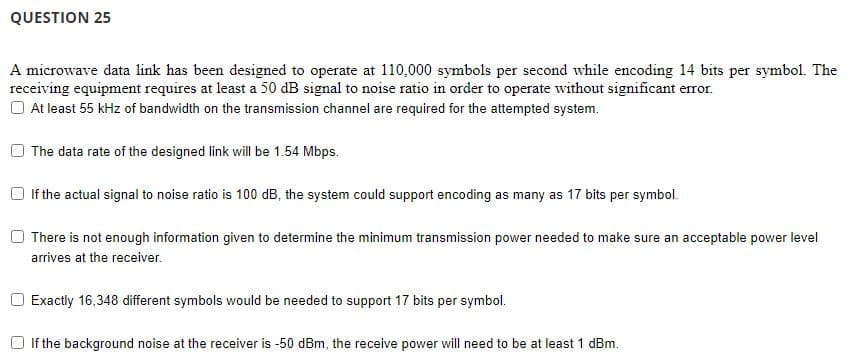microwave data link has been designed to operate at 110,000 symbols per second while encoding 14 bits per symbol. eceiving equipment requires at least a 50 dB signal to noise ratio in order to operate without significant error. At least 55 kHz of bandwidth on the transmission channel are required for the attempted system. The data rate of the designed link will be 1.54 Mbps. If the actual signal to noise ratio is 100 dB, the system could support encoding as many as 17 bits per symbol. There is not enough information given to determine the minimum transmission power needed to make sure an acceptable power lev arrives at the receiver. Exactly 16,348 different symbols would be needed to support 17 bits per symbol. If the background noise at the receiver is -50 dBm, the receive power will need to be at least 1 dBm.
microwave data link has been designed to operate at 110,000 symbols per second while encoding 14 bits per symbol. eceiving equipment requires at least a 50 dB signal to noise ratio in order to operate without significant error. At least 55 kHz of bandwidth on the transmission channel are required for the attempted system. The data rate of the designed link will be 1.54 Mbps. If the actual signal to noise ratio is 100 dB, the system could support encoding as many as 17 bits per symbol. There is not enough information given to determine the minimum transmission power needed to make sure an acceptable power lev arrives at the receiver. Exactly 16,348 different symbols would be needed to support 17 bits per symbol. If the background noise at the receiver is -50 dBm, the receive power will need to be at least 1 dBm.
Computer Networking: A Top-Down Approach (7th Edition)
7th Edition
ISBN:9780133594140
Author:James Kurose, Keith Ross
Publisher:James Kurose, Keith Ross
Chapter1: Computer Networks And The Internet
Section: Chapter Questions
Problem R1RQ: What is the difference between a host and an end system? List several different types of end...
Related questions
Question

Transcribed Image Text:QUESTION 25
A microwave data link has been designed to operate at 110,000 symbols per second while encoding 14 bits per symbol. The
receiving equipment requires at least a 50 dB signal to noise ratio in order to operate without significant error.
At least 55 kHz of bandwidth on the transmission channel are required for the attempted system.
The data rate of the designed link will be 1.54 Mbps.
If the actual signal to noise ratio is 100 dB, the system could support encoding as many as 17 bits per symbol.
There is not enough information given to determine the minimum transmission power needed to make sure an acceptable power level
arrives at the receiver.
Exactly 16,348 different symbols would be needed to support 17 bits per symbol.
If the background noise at the receiver is -50 dBm, the receive power will need to be at least 1 dBm.
Expert Solution
This question has been solved!
Explore an expertly crafted, step-by-step solution for a thorough understanding of key concepts.
This is a popular solution!
Trending now
This is a popular solution!
Step by step
Solved in 4 steps

Recommended textbooks for you

Computer Networking: A Top-Down Approach (7th Edi…
Computer Engineering
ISBN:
9780133594140
Author:
James Kurose, Keith Ross
Publisher:
PEARSON

Computer Organization and Design MIPS Edition, Fi…
Computer Engineering
ISBN:
9780124077263
Author:
David A. Patterson, John L. Hennessy
Publisher:
Elsevier Science

Network+ Guide to Networks (MindTap Course List)
Computer Engineering
ISBN:
9781337569330
Author:
Jill West, Tamara Dean, Jean Andrews
Publisher:
Cengage Learning

Computer Networking: A Top-Down Approach (7th Edi…
Computer Engineering
ISBN:
9780133594140
Author:
James Kurose, Keith Ross
Publisher:
PEARSON

Computer Organization and Design MIPS Edition, Fi…
Computer Engineering
ISBN:
9780124077263
Author:
David A. Patterson, John L. Hennessy
Publisher:
Elsevier Science

Network+ Guide to Networks (MindTap Course List)
Computer Engineering
ISBN:
9781337569330
Author:
Jill West, Tamara Dean, Jean Andrews
Publisher:
Cengage Learning

Concepts of Database Management
Computer Engineering
ISBN:
9781337093422
Author:
Joy L. Starks, Philip J. Pratt, Mary Z. Last
Publisher:
Cengage Learning

Prelude to Programming
Computer Engineering
ISBN:
9780133750423
Author:
VENIT, Stewart
Publisher:
Pearson Education

Sc Business Data Communications and Networking, T…
Computer Engineering
ISBN:
9781119368830
Author:
FITZGERALD
Publisher:
WILEY